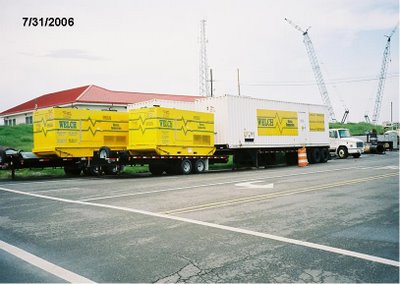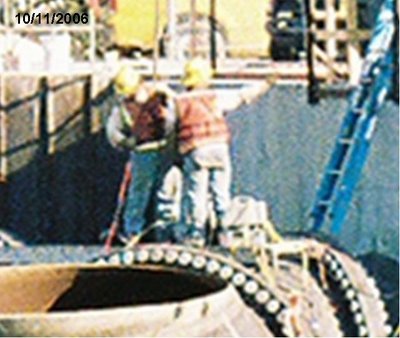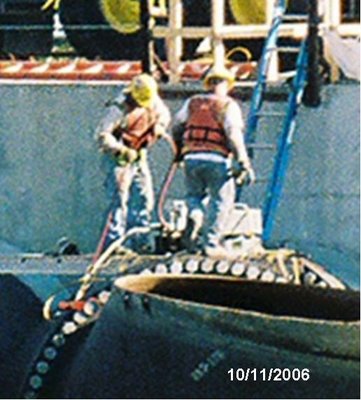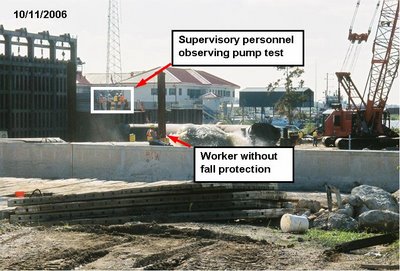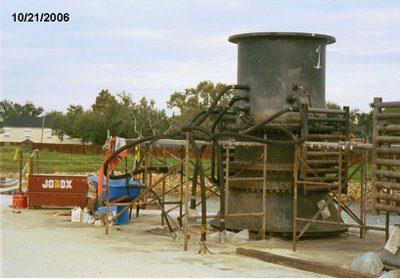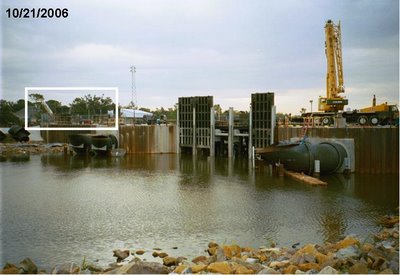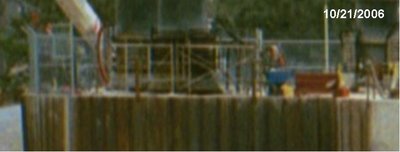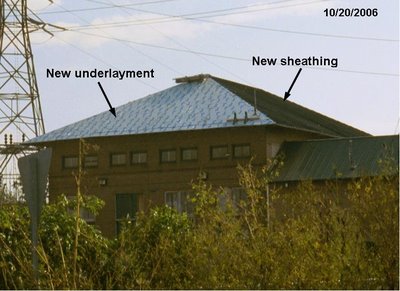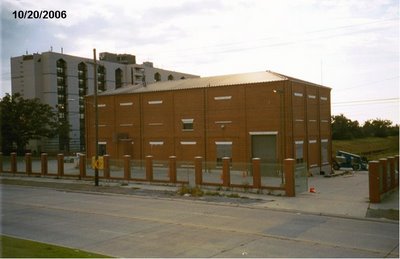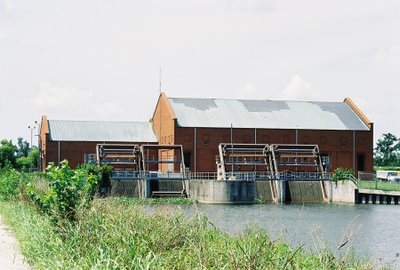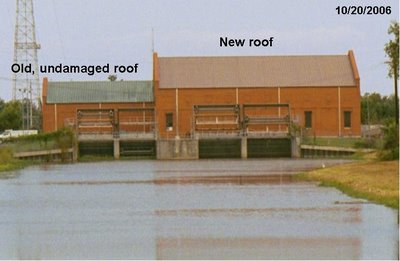I have inserted the pictures that go with this post, and I have also modified some of the text. Since the changes make such a difference in the feel of the post, I am reposting the whole thing today. Enjoy.
As I've mentioned
earlier, the Corps tests the floodgate pumps out of the media spotlight quite often. October 11 was one of those times.
I visited all three outfall canal sites on the 11th and found there are a significant amount of changes going on at all three canals. Remember when the Corps invited the media to witness their testing of the pumps last month at the
Orleans Avenue and
London Avenue canals, and they temporarily turned the discharge pipes upward? There's a picture of a September 20 London Avenue test (which was not open to the press) showing this on page 5 of
this Corps update. Here's the picture:

The idea was to roughly simulate storm surge conditions on the lake side of the gates by forcing the water to push against something - the upturned discharge. Well, they are making that change permanent by actually slicing off large chunks of those pieces of the pipe and turning the pipe 180 degrees so its discharge will permanently point skyward.
For reference, here is what the pump discharges at the 17th Street canal looked like before:

On the 11th, they were testing the effectiveness of those changes by running three of the pumps on the west side of the 17th St canal after altering the pipes on that side of the canal. The pipes on the east side of the canal are in the process of being modified. Here's a couple of pictures of the testing on the west side of the canal from October 11th. I have highlighted and labeled the modified discharge pipes.


Here's a welder cutting off what is known as a "padeye" on the east side discharge, in anticipation of slicing the entire end of the pipe off:

These changes are also being implemented at the other two outfall canal gate structures. They have done two of the four discharge pipes at Orleans Ave., and two of four at London Ave. as well.
Here's Orleans Avenue:

And here's London Avenue:

In addition, five of the ten Orleans Avenue pumps have been pulled out a second time, assumedly for further repairs. This is
very surprising.
Supposedly, the Corps had finished messing with the pumps. Here's a quote from the Times-Picayune article that described the September 14th Orleans Ave testing:
"After the vibration problems surfaced last month, the corps and its contractors building post-Katrina floodgates and pumping systems on the Orleans Avenue, London Avenue and 17th Street canals had the motors in all 34 new
pumps [emphasis mine] retrofitted in hopes of reducing the shaking."
But now five of them are out - again. So what is the reason for the pumps being pulled again? The pumps are currently sitting on the east side of the deck at the Orleans Ave. gates. Here's a picture with the pumps highlighted:
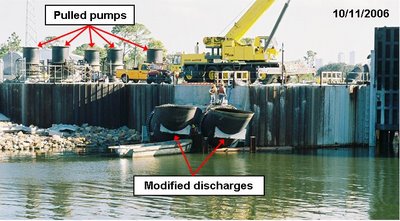
What does all this mean? As I see it, there are two possible explanations:
Explanation 1. The change is closely related to the vibration problems. Turning the discharge pipe outlets upward would help keep the pipes full of water during testing and operating. However, such a solution would be
totally different from what the Corps said was the problem: hydraulic motors. Coupled with the fact that the pumps have been pulled at Orleans Avenue a second time, I think the pump vibration story is still going. I'm wondering if the vibration problem is permanent and this modification to the piping is the Corps' way of simply living with it.
This is a little (not a lot) worrying, because it seems that "living with it" entails a decrease in pumping capacity. According to
the September 16th Times-Picayune article about the London Avenue testing, the pumps are to be run at reduced capacity:
"Two pumps that were run at almost 85 percent capacity [my emphasis] did not vibrate, and a third experienced an insignificant amount of pulsation, said Col. Jeffrey Bedey, commander of the Army Corps of Engineers' Hurricane Protection Office."
So in order to keep the shaking away, they can't run the pumps full out?
Explanation 2. The Corps realized they didn't follow their own regulations for backflow prevention, as found at the bottom right of page 1
here, and are rectifying the situation. That is, the original design for the pump discharge lines only included a single method of backflow prevention (siphon breaker valves), while the regulation says, "...two means shall be provided to prevent backflow when the discharge is through the protection." I think this idea of correcting the design is a more remote possibility. However, on the good side, the change does make backflow a little less likely.
For more about backflow prevention at the gates, you can read
this post.
In any case, I think the Corps needs to update the public on why they are literally slicing and dicing a design that has already been constructed. It certainly brings into question how adequate the rest of their design is and whether they'll be making other changes. However, if it is meant to improve things, they should say so. They're so reticent to announce any news, even when it's good news.
In other floodgate news, the Corps is moving toward installation of automatic hydraulic winches at all three gates. This is good. It will eventually take the cranes out of the equation. The cranes currently raising and lowering the gates cannot operate in winds over 30 mph. With the automatic winches, that problem goes away, meaning the gates can be lowered at a time much closer to landfall, which in turn means that the city can continue to pump out rainwater for much longer.
The winch installation at 17th St was finished about 2.5 weeks ago, but the winches are not operational yet. Here they are highlighted:

And here's a blowup from that picture:

Note the green straps. That's what the crane hooks on to in order to raise and lower the gates.
Since the winches are working yet, they are still using a crane to move the gate sections up and down at 17th Street. Here's a picture of the crane doing so with needle gate number two:

Here's a detail from the above photo. It shows the workers handling the crane line and the green straps just after securing needle gate number two:

At London Ave, they have actually removed four of the gate sections completely (a scary sight considering we're still in hurricane season) in anticipation of installing a framework to support the winches. The winches are on site and can be seen on the west side of the gates. Here's a closeup of them:

They have not begun winch work at Orleans Avenue yet.
You can find the exact model of winches at
this link.
Finally, it is worth pointing out again that the Corps missed a deadline at the 17th Street gates at the beginning of this month. You can find the deadline at
this webpage. They were supposed to have two extra pumps on line on the Orleans side of the canal on September 30th. The pumps are not ready, and won't be for a number of weeks. Here's a picture of the platform on the east side with both pumps not hooked up:

In addition, the Corps is supposed to have four more pumps ready on the Jefferson side of the canal by the end of this month. They will definitely not be ready. The pumps and their engines have not even arrived on site yet, and the Corps only started driving piles for the platform to hold those pumps within the last three weeks. The Corps will be fortunate to have those four pumps running by Thanksgiving.
And once again, here's the picture of the west side, in which I've noted the beginning of the work for the quartet of pumps:




